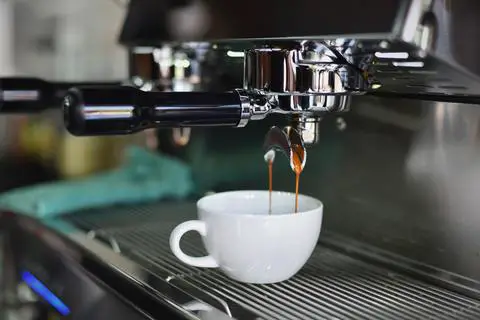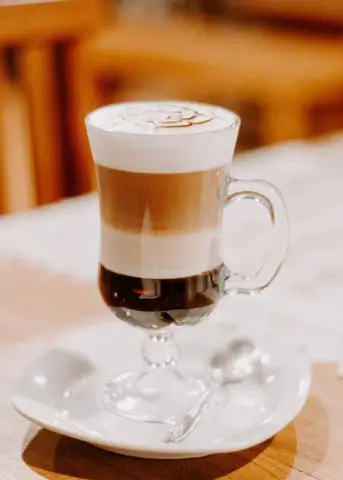What do you prefer – coffee or dessert? This is a question that can easily escalate into a heated debate! But thanks to the versatility of coffee, you can have a bit of both by preparing an espresso con panna. Wondering what we’re talking about? Read on to find out!
For your information, if you click on a product on Jayarrcoffee.com and decide to buy it, we may earn a small commission.
Table of Contents
An Overview of Espresso Con Panna
So, what is espresso con panna? Espresso con panna (pronounced: kon PAAN-nah) is essentially a dollop of whipped cream placed on a shot of espresso.

Unsurprisingly, it’s an Italian term that roughly translates to “espresso with cream.” Based on the ingredients and method of serving, an espresso con panna bears a close resemblance to a Vienna. An Espresso Con Panna is also referred to as a Caffe Con Panna at some coffeehouses (like Peet’s).
Despite the hints of Italian origin in its name, the espresso con panna has a vague history. There are suggestions that it may have started in Vienna coffeehouses, but it also may have originated in Germany or even Turkey. The coffee is traditionally served in a demitasse cup, which is generally associated with Turkish coffee.
Depending on who you ask and the region, an espresso con panna may also be referred to as café Vienne (United States), café Viennois (the United Kingdom and France), Franziskaner (in Vienna), or Wiener Mélange. This is all terribly confusing to most people since these terms can also refer to entirely different espresso drinks!

Our advice: Try and specify that you want an authentic espresso con panna – i.e., with only a single/double shot of espresso and whipped cream!
Flavor Profile of an Espresso Con Panna
As dramatic as this might sound, an espresso con panna is a blissfully synergistic combination of ingredients – just like peanut butter and jelly. The coffee has a balanced flavor with neither ingredient overpowering the other; instead, the coffee’s inherent bitterness compliments the cream’s sweetness – and vice versa. There’s also something particularly nice about how the beverage transitions from the cold/exciting layer on top to a warm/comforting elixir underneath. Characteristic of espresso drinks generally, the espresso con panna has a long and full flavor that leaves a tingle on your palate.

Ultimately, espresso con panna’s flavor is highly dependent on the coffee beans. Be sure to experiment with different single origins- try an Ethiopian, then a Colombian, then a Sumatra Mandheling, then a Tanzanian Peaberry to get a feel for huge variance in taste possible!
Espresso Con Panna Vs Café Mocha

If the idea of adding whipped cream to coffee intrigues you, note that an espresso con panna is not the only drink that features this combination; the café mocha also often features whipped cream (although not always!). In many ways, the café mocha bears a close resemblance to an espresso con panna, but with a few noteworthy differences:
Flavor Profile
While an espresso con panna does an admirable job in exciting your sweet tooth, the coffee drink doesn’t compare to the sweetness of a café mocha, featuring steamed milk, whipped cream and chocolate.
Calories and Caffeine Content
Below is a comparison of the relevant caffeine, calories, and dietary cholesterol in both an espresso con panna and a café mocha:
| Espresso Con Panna | Café Mocha | |
| Serving Size | 1.5 fluid ounce (double shot) | 16 fluid ounces |
| Caffeine content | 150 mg | 175 mg |
| Calories | 35 | 360 |
| Cholesterol | 10 mg | 50 mg |
As you can see above, an espresso con panna is lighter on all three of calories, caffeine content, and dietary cholesterol. Part of this difference is a function of the serving size- 1.5 fluid ounces in an espresso con panna vs. the 16 fluid ounces in a café mocha. However, the addition of steamed milk and chocolate make the café mocha a significantly more calorie rich drink. The chocolate additionally increases the amount of caffeine.

How to Make Espresso Con Panna
Looking to add some energy and sweetness to your day? As complicated as the name might sound, it only takes about 5 minutes and a few ingredients to prepare a great espresso con panna. Below is an in-depth recipe to get you started in the comfort of your home (you will need an espresso machine, or at least a moka pot):
Ingredients
- Quality heavy cream (around 20%) – or a low-fat option
- A clean bowl
- A whisk
- Finely ground coffee beans
- Espresso machine/moka pot
- Espresso cup, small glass, or a demitasse cup
Preparing the Ingredients
- The first step is to ensure your whipped cream is both creamy and consistent. To condition the whipped cream, whisk it for about a minute. Don’t overdo the whisking – or the whipped cream may start to ooze a bit. The resulting texture should be light and fluffy. After you achieve the right consistency, place the whipped cream in the fridge while you brew your espresso.
- Pull the Espresso shot: For brewing the espresso, you’ll need either an espresso machine or a moka pot. For instruction on using a moka pot, see our guide here and our video below:
Instructions
- Pull a shot (or two) of hot espresso and pour it into a cup.
- Take your whipped cream and garnish the espresso shot with as much cream as desired. Most people prefer one or two tablespoons for a cup.
- Traditionally, you’re not supposed to add sugar or any other sweetener to an espresso con panna, but you can get a bit creative by sprinkling on cocoa or cinnamon.
- Serve in an espresso cup, small glass, or a demitasse cup
- Enjoy your beverage!

Once you try an espresso con panna, you’ll be chugging them down regularly in no time! If you choose to go old school by foregoing sweeteners and flavorings, expect the drink to be espresso forward (initially bold and bitter) then sweetly finished by the whipped cream. And for coffee enthusiasts who are always on the go, espresso con panna is available at Starbucks and Peet’s Coffee (called a Caffe Con Panna).
